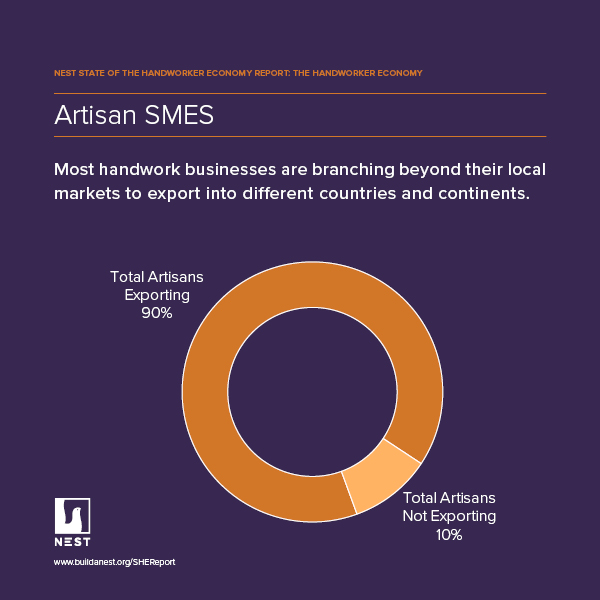
Nest's State of the Handworker Economy Report is Here!
Recognizing a gaping lack of data on the informal economy—and more specifically, on the handworker economy, which is estimated to account for a large portion of informal work – we are proud to unveil our first-ever State of the Handworker Report, a comprehensive report housing troves of descriptive data on artisan small to medium sized enterprises (SMEs) and home-based workers engaged in craft work.
GET THE REPORT
From our Contributors
Eco-Age Co-Founder, Livia Firth: “I can think of no form of production that better exemplifies the principles of consciousness, intention, and cultural preservation than that of hand craftsmanship. But we cannot connect the dots between craft, culture, and fashion without data. Data helps us measure not only what has been lost and will be lost, but also what is taking place right now.”
OECD Policy Advisor, Jennifer Schappert: “Transparency, while not an end in of itself, is an important pre-condition for upholding the rights of workers. The collection of consistent data should help to drive company resources towards interventions that can increase the visibility of handworkers, protect their rights, and give them avenues for accessing remedy.”
Bloomberg Philanthropies Women’s Economic Development Program Lead, Verna Eggleston: “Often times there is little reliable information on behalf of groups that have been marginalized and placed at a disadvantage. It is critical for these populations to have a role in voicing their own narratives. In the absence of data and narrative, these groups becomes invisible. I guarantee you that you will find the information in this report eye-opening and valuable to any and all efforts to improve and understand the “world of work”.
CFDA President, Steven Kolb: “I am thrilled that CFDA was able to contribute to Nest’s report so that we can all gain a more fact-based understanding of the ways designers are utilizing handcraft, what challenges they are facing in doing so, and what potential there is for these relationships to grow. The fashion collections of today and tomorrow will certainly be all the better for it.”
GLG Social Impact Director, Jen Field: “GLG was proud to have Nest as one of its Social Impact Fellows, helping to dramatically expanded its access to primary insights through our program. Advancing the global handworker economy requires a broad array of inputs, so Nest set out to ask questions, cull the best data, and go directly to the source whenever possible. This report reflects – and validates—that ambition and commitment.”
Etsy Global Head of Advocacy and Impact, Althea Erickson: “As a global online marketplace that supports over two million sellers around the world, Etsy has a deep understanding of creative entrepreneurs and the unique challenges they face. Using data to track shifts in the maker landscape enables us to evolve our efforts and more effectively help these entrepreneurs succeed.”
With contributions from

Verna Eggleston, Bloomberg Philanthropies

Livia Firth, Eco-Age

Althea Erickson, Etsy

Steven Kolb, CFDA

Rachel Wald, Gerson Lehrman Group

Jennifer Schappert, OECD

Douglas Guiley, West Elm & Williams-Sonoma Inc.

Rebecca van Bergen, Nest
Facts and Figures




About the Report
The International Labor Organization estimates 300M homeworkers globally, but does not specify how many are engaged in craft production. Estimates with wide variability suggest anywhere between 20-60% of garment production leaves the factory to be subcontracted to a home. And Research and Markets recently indicated that the global handicrafts market reached US $526.5 billion in 2017, expected to reach $984.8 Billion by 2023.
Through our Nest Guild network of artisan SMEs engaging with Nest’s pro bono capacity building tools, Nest has gathered a robust set of descriptive data on close to 500 SMEs across more than 90 countries. The dataset surfaces insights into current practices, needs and trends across artisan businesses using a wide range of hand production models. Findings, combined with a fresh body of compliance and worker wellbeing data collected during over 50 onsite assessments as part of Nest’s newly launched compliance program for homes and small workshops, have facilitated our ability to gain unprecedented visibility into previously hidden supply chains beyond the four walled factory.

ARTISAN BUSINESSES AND SMES
1. Artisan businesses are powerful vehicles for women’s employment with most artisan businesses employing a majority female workforce. Women are documented to invest more earnings in their families and communities than their male counterparts, pointing to opportunity for craft-based work to drive both economic and social impact. Many artisan businesses cite gender equity as a primary cornerstone of their social missions.
2. Artisan businesses have exporting capabilities and most are already engaging in some level of product export beyond the local marketplace. This said, many artisan businesses sell in local markets despite their export capabilities, pointing to an untapped opportunity for expansion into new international markets.
3. Artisan businesses tend to grow their technology use as their companies grow over time. However, most businesses are limiting their technology use to basic platforms and social media like email, Facebook and Instagram, instead of utilizing the full scope of new and relatively inexpensive technologies like Google for business, CRM software, and selling platforms like Shopify.
INDUSTRY PLAYERS
1. More than one-third of companies who reported subcontracting to small workshops/homeworkers said that they do not have specific auditing processes in place for assessing production in these work environments. This points to a need for a reliable system that assesses home-based work. When assessments do take place, home visits are not common, pointing to a lack of visibility to the primary producer at the “bottom” of the supply chain.
2. A lack of industry standardization exists when it comes to assessing home or small workshop-based production. Most brands reported using standards set internally by their own companies as opposed to engaging third parties, pointing to an opportunity for the industry to better align on a universal, standardized system for validating work beyond the factory.
3. Brands are interested in programs that not only afford supply chain visibility but also include ways to remediate aspects of their supply chain that need improvement. Brands seem to want to be a part of the solution and are willing to invest in improving compliance in their supply chains.

HANDWORKERS AND HOMEWORKERS

1. Clear and consistent record keeping and documentation is a major challenge in documenting home-based work, making wage payments and hours worked difficult to track. Improved, standardized, and likely digitized record keeping systems are needed to make sure that handworkers are not exploited.
2. Home-based work environments pose unique safety challenges to handworkers, largely due to a lack of training on health and safety-promoting measures. Concerted training catering specifically to the unique home environment, in which most factory safety standards do not apply, is needed.
3. Handworkers are almost universally paid with piece rate wages as opposed to a salary. While there is nothing inherently wrong with piece-rate payments, the methodology for determining per piece work is often poorly defined or nonexistent, contributing to a greater likelihood that handworkers will be paid unfairly. Standardized methodology for implementing time motion studies should be implemented to ensure fair wages to handworkers.
WOMEN AND MOTHERS
1. Women doing handwork are invested in their children’s education, with many reporting that their primary use of income generated through handwork is to put children through school. In contrast, child’s education is not a financial priority for men.
2. Women feel that home‑based work is helping them to better care for the children and this ability to parent seems to be what women consider the primary benefit of home-based work.
3. Home-based work serves as an important alternative to factory work, particularly for mothers, who find that their family care demands prohibit them from working in factories. The need to care for children is the primary reason why women leave work in a factory to do handwork inside the home, making home-based work an important alternative for women who might otherwise have to stop working altogether.

This Report was made possible with the support of Bloomberg Philanthropies
